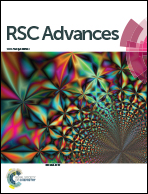Preparation of bulk AgNWs/PEDOT:PSS composites: a new model towards high-performance bulk organic thermoelectric materials
Abstract
A facile and effective approach is demonstrated to prepare high-performance bulk AgNWs/PEDOT:PSS thermoelectric composites. The thermoelectric properties of the samples with different AgNWs contents are investigated in detail. The results show that well-dispersed AgNWs in the bulk PEDOT:PSS can give rise to a much higher electrical conductivity without a noticeable decrease in Seebeck coefficient or increase in thermal conductivity, which suggests the achievement of decoupling and optimizing the electrical conductivity and Seebeck coefficient. Consequently, the maximum ZT is observed to be 340% larger than that of the pure PEDOT:PSS sample. Our work clearly proves that the introduction of AgNWs is a promising model to significantly improve the thermoelectric properties of bulk organic-based TE materials.


 Please wait while we load your content...
Please wait while we load your content...